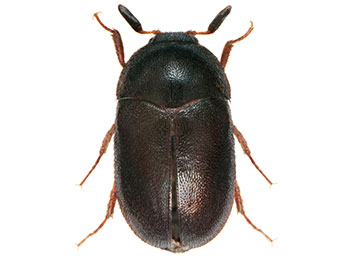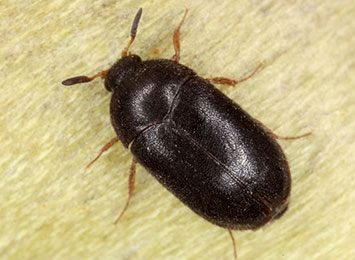Black carpet beetles belong to the scientific order Coleoptera. They are the most common and most destructive type of carpet beetle found in the United States. A carpet beetle infestation can damage household products that contain keratin, plant products, and synthetic fabrics.
Black Carpet Beetle Pest Control
What are black carpet beetles?

What do black carpet beetles look like?
Black carpet beetles are pill-shaped, approximately 1/4” long, and are black or dark brown. Adult black carpet beetle legs and antennae may look slightly lighter brown than their bodies.
Black carpet beetle larvae resemble caterpillars. They’re cigar or carrot-shaped and look slightly longer and narrower than their adult counterparts. They have distinctive long, curled, golden-brown hair protruding from their tail-end. At the beginning of each step in the carpet beetle’s life cycle, they may appear pale or even white but will darken quickly with age.
Signs of a black carpet beetle infestation
Black carpet beetle larvae eat large, irregular holes through food sources like carpet, upholstery and textiles. As they eat, larvae leave behind shed skin near their food. This skin is very flakey and often breaks down into dust-like material that you might notice on fabrics or stored foods.

How to get rid of black carpet beetles
Carefully inspect dark areas such as basements, pantries, boiler rooms, and attics, look for beetles on either organic products such as wool or feathers or stored food products. Vacuum up beetles, larvae, and eggs you find. Throw out infested food and wash infested fabrics thoroughly. Pay special attention to pet bedding and shed fur. Make sure doors and screens are sealed so adult beetles can’t fly into your home.
New York Carpet Beetle Control
Carpet beetles can be difficult to locate, identify and eliminate. If you’re facing a carpet beetle infestation, contact Assured Environments. We provide exceptional carpet beetle control in New York, New Jersey, and Connecticut!
Carpet Beetle FAQ
Are carpet beetles harmful?
Carpet beetles aren’t directly dangerous to human beings unless you’re allergic to them. The biggest problem is the damage they can do by chewing holes into your textiles.
What do carpet beetle eggs look like?
Carpet beetle eggs are tiny - less than .01 inch long. They are white or cream colored, oval shaped and often found among unused clothes, blankets, furs and carpeting.
How do I know if I’m allergic to carpet beetles?
Carpet beetle larvae rash occurs when larvae in your bed brush up against your skin. If you’re allergic, you’ll experience mild swelling and redness. Unlike bed bugs, which bite humans, carpet beetle larvae are only interested in your sheets and blankets.
Are carpet beetles the same as bed bugs?
No. While both are small and can be found in your bed, they are not the same insect. Learn to tell the difference between bed bugs and carpet beetles.
What causes carpet beetles?
Adult carpet beetles fly in search of nesting locations to lay their eggs. Carpet beetles are attracted to animal-based fabrics like wool, silk, fur and leather. They will deposit their eggs your home if they find these readily available for their offspring to eat.

